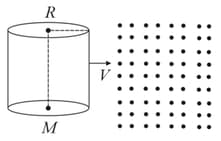Stokes Law
Stokes Law: Overview
This topic covers concepts, such as, Stokes Law, Viscous Force on Spherical Bodies, Velocity of Spherical Ball in Viscous Medium, Terminal Velocity of Spherical Ball, Applications of Stokes Law & Velocity of Rain Drops etc.
Important Questions on Stokes Law
A spherical ball of radius and density falls freely under gravity through a distance before entering a tank of water. If after entering the water the velocity of the ball does not change, find . The viscosity of water is .
The constant velocity of the raindrop is because of _____.
A raindrop falling in air is similar to motion of what kind of body in viscous medium?
Falling rain drops velocity vary with the height with respect to the surface.
Stoke's can be applied for the measurement of the viscosity of fluids
List the applications of Stokes Law.
A lead ball of diameter falls through a long column of glycerine. The variation of its velocity with distance covered is represented by
A cylinder of mass and radius moves with constant speed through a region of space that contains dust particles of mass which are at rest. There are number of particles per unit volume. The cylinder moves in a direction perpendicular to its axis. Assume and that the particles do not interact with each other. All the collisions taking place are perfectly elastic and the surface of the cylinder is smooth. The drag force per unit length of the cylinder required to maintain a speed constant for the cylinder when it has entered a region is . Find the value of .

Two balls of radii and are released inside a deep water tank. Their initial accelerations are found to be and respectively. If the velocity of smaller ball relative to the larger ball a long time after the two balls are released is upwards. If is then find . (Coefficient of viscosity of liquid is and density of liquid is ).
Eight identical drops of water, each of radius are falling through air at a terminal velocity of . If they coalesce to form a single drop, then the terminal velocity of the combined drop will be :
Best graph from following between terminal velocity of a spherical object and radius of object is
In Millikan's oil drop experiment, what is the terminal speed of an unchanged drop of the radius of and the density ? Take the viscosity of air at the temperature of the experiment to be . The viscous force on the drop at that speed is . What is the value of ?
(Write to the nearest integer & neglect buoyancy of the drop due to air)
A drop of water of radius is falling in air. If the coefficient of viscosity of air is , the terminal velocity of the drop will be: (The density of water and )
Eight drops of water, each of radius are falling through air at a terminal velocity of . If they coalesce to from a single drop, then the terminal velocity of combined drop will be:
A metallic sphere of mass falls through glycerine, If we drop a ball of mass of same metal into a column of glycerine, the terminal velocity of the ball will be
A spherical ball of radius is falling in a viscous fluid with velocity . The retarding viscous force acting on the spherical ball is:
A copper ball of radius is moving with a uniform velocity in the mustard oil and the dragging force acting on the ball is The dragging force on the copper ball of radius with uniform velocity in the mustard oil is
A rain drop of radius has a terminal velocity in air The viscosity of air is poise. Find the viscous force on the rain drops.
What will be the approximate terminal velocity of a rain drop of diameter , when density of rain water and the coefficient of viscosity of air ?
Two spheres of radii and is dropped through a tube full of glycerine. Their terminal velocities and are calculated in the experiment. Which of the following is true?
